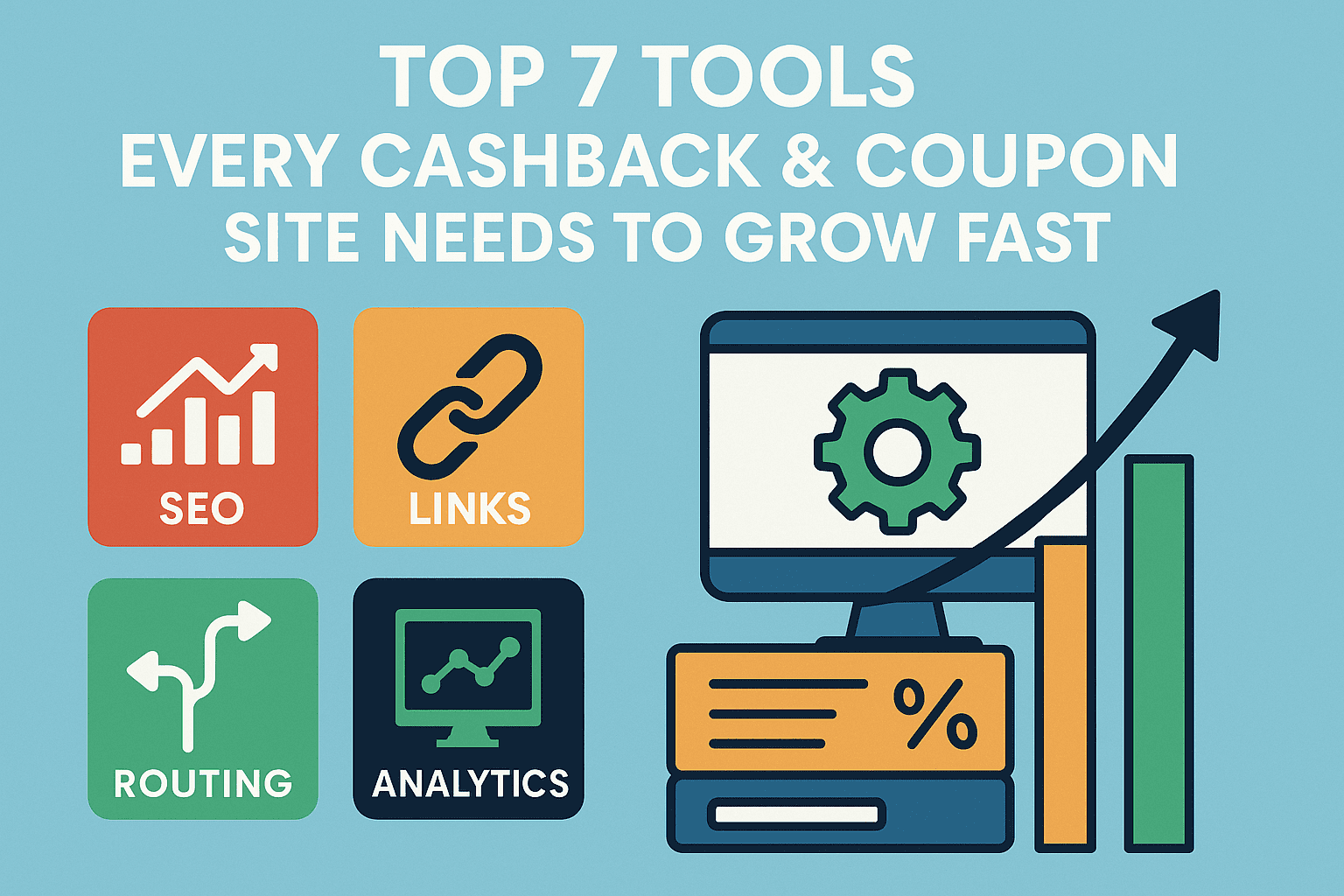Top 7 Tools Every Cashback & Coupon Site Needs to Grow Fast

Running a cashback site is not only about posting offers. It is a daily fight for clean data, fast pages, and reliable tracking. The right stack of tools frees up your time, spots the leaks, and helps you ship updates without breaking what already works. Below is a practical list of seven tools that lift performance for affiliate publishers who run cashback, coupons, or hybrid content sites.
How to use this guide
For each tool you will see what it is, why it matters to a cashback site, quick steps to get value fast, and one practical tip that saves time in the real world. You will also find stack recipes and a measurement checklist at the end.
1) Yoast SEO
What it is
A WordPress plugin that provides on-page SEO guidance, schema support, and internal linking assistance.
Why it matters for cashback
Cashback sites often publish thousands of store and category pages that look similar to search engines. Yoast helps you set clean title templates, write consistent meta descriptions, manage canonicals, and highlight cornerstone content. That reduces duplication, improves crawl clarity, and helps search snippets reflect your actual offers.
Quick start
- Install in staging, then production after a short smoke test.
- Set title and description templates that pull store name, incentive, and category.
- Enable and validate schema types appropriate for your templates.
- Use internal linking suggestions to strengthen store hubs and seasonal pages.
Pro tip
Create a two-page meta copy style guide so editors avoid vague promises. Clear incentives in titles and descriptions protect click-through and trust.
2) Semrush
What it is
A comprehensive platform for keyword research, competitive analysis, site auditing, and rank tracking.
Why it matters for cashback
Brand + cashback is only the start. You also need seasonal voucher queries, category terms, and merchant-specific product clusters. Semrush helps you map real demand to the correct page types and monitors whether your changes move the needle. The site audit flags crawl and performance issues that quietly erode rankings on large inventories.
Quick start
- Build a keyword universe for store, category, and editorial guides.
- Map keywords to page types rather than posting everything as a blog.
- Run weekly audits and fix 4xx, duplicate titles, and thin content.
- Track priority merchants and monitor share of voice against competing affiliates.
Pro tip
Group keywords by intent. A voucher query belongs on a store page with live offers. A “how to install” query belongs in an editorial guide. Matching intent to page type lifts conversion without extra traffic.
3) Screaming Frog SEO Spider
What it is
A desktop website crawler that surfaces titles, canonicals, response codes, structured data, and more.
Why it matters for cashback
Offer templates change, merchants rotate links, and pages multiply. A weekly crawl catches broken internal links, redirect loops, soft 404s, and duplicate titles across country or currency variants. You fix issues before search engines see a messy site.
Quick start
- Crawl the full site and export reports for 3xx and 4xx codes.
- Check canonical rules for pagination and filters.
- Use custom extraction to verify that required affiliate parameters exist in outbound links.
- Recrawl after deployments and compare deltas.
Pro tip
Set a small dashboard that shows the count of new 4xx and title changes since the last crawl. Spikes usually mean a template or deployment needs attention today, not next week.
4) ThirstyAffiliates
What it is
A WordPress link management plugin that stores, brands, and tracks affiliate URLs from a central place. It offers link cloaking, categorisation, and simple reporting.
Why it matters for cashback
Clean tracking is the backbone of your revenue. Cloaked links protect long URLs from accidental edits and keep your parameters intact. Centralised records stop duplicate links across editors, and automatic checks reduce link rot. If you run comparison tables or evergreen guides, a reliable link manager prevents silent revenue loss.
Quick start
- Import your top merchant URLs and standardise the slug format.
- Add default SubID parameters for sitewide attribution.
- Enable keyword-to-link features where appropriate; whitelist critical pages to maintain control.
- Turn on 404 monitoring to catch dead destinations early.
Pro tip
Use a naming convention for groups and placements. When reports align with real placements, you can retire underperforming modules faster.
5) FMTC Datafeed
What it is
A curated coupon and deal feed that aggregates promotions from many programmes, enriches the data, and publishes standardised outputs that are easier to ingest.
Why it matters for cashback
Coupon freshness and accuracy decide whether users trust your pages. Pulling directly from multiple networks often creates duplicate and inconsistent records. A cleaned feed reduces editorial time, ensures terms are present, and retires expired offers promptly. It becomes the backbone of your store pages and category hubs.
Quick start
- Map FMTC fields to your internal offer schema.
- Ingest on a schedule that fits traffic patterns (e.g., hourly during retail peaks).
- Enforce validation rules, live landing pages, future end dates, visible terms.
- Give editors a priority score so the best offers surface automatically.
Pro tip
Keep an audit trail of offer changes and status. When a merchant questions a payout, you can show exactly what shoppers saw on a given date.
6) Geniuslink
What it is
A smart link routing platform that sends visitors to the best destination by country, device, or other context. It can also test alternatives and build choice pages.
Why it matters for cashback
Many merchants operate separate storefronts. Sending a UK shopper to a US product page kills conversion. Routing by country and storefront fixes that. A/B testing lets you compare direct-to-product versus store homepage, and choose the winner by real clicks and sales.
Quick start
- Replace legacy links for your top merchants with smart links.
- Add routing and fallback rules for unsupported regions.
- Tag links with SubIDs so network reports show placement-level performance.
- Test choice pages against deep links and keep the better performer.
Pro tip
Pair smart routing with your link management plugin. Editors use a single friendly URL, while the routing layer handles location/device logic behind the scenes.
7) Google Tag Manager (server-side) + Microsoft Clarity
What they are
GTM centralises scripts and pixels. Server-side tagging moves parts of data collection to your subdomain, improving control and often data quality. Clarity provides free heatmaps and session recordings that show user behaviour on store and offer pages.
Why they matter for cashback
Attribution accuracy pays the bills. GTM keeps tracking consistent across thousands of pages. Server-side setups reduce client-side loss and give you more control over what leaves your site. Clarity reveals friction that is invisible in aggregate analytics, such as rage clicks on disabled buttons or confusion around coupon terms.
Quick start
- Audit current tags; deploy a clean GTM container with naming standards.
- Move analytics and supported pixels to server-side in phases.
- Add Clarity to priority sections; review heatmaps for store hubs weekly.
- Turn findings into quick experiments (shorter terms, clearer buttons).
Pro tip
Set goals by page type. On a store hub, lift clicks on the primary offer module. On a comparison, lift outbound CTR to in-stock items. Measure before/after each change.
Stack recipes that work
Launch fast on WordPress
Yoast SEO for on-page hygiene, ThirstyAffiliates for link control, Microsoft Clarity for behaviour insights. Crawl weekly with Screaming Frog and fix broken links or duplicate titles. Simple changes here usually lift organic traffic and conversions without new content.
Coupon-first content engine
Use FMTC as your source of truth for coupons and deals. Schedule hourly imports, validate terms/expiry, and auto-retire out-of-date offers. Use Semrush to expand into seasonal voucher keywords and to monitor gains at the store and category level.
Global audiences with clean routing
Adopt Geniuslink for country/device routing, supported by server-side GTM to protect attribution. Keep SubID parameters consistent so reporting ties back to placements. Confirm with Clarity that users land on the correct storefront and progress to checkout.
Measurement checklist for cashback publishers
- Outbound CTR by store and by offer position.
- EPC by placement using a stable SubID pattern.
- Link health: failing redirects and mean time to repair.
- Offer freshness: % due to expire in the next 7 days.
- Crawl errors, duplicate titles, missing canonicals.
- Conversion lag, pending vs locked, reversal rate by merchant.
- Behaviour signals: rage clicks, dead clicks, scroll depth on store hubs.
Gaps your competitors often miss
- SubID discipline: document a simple format for page, placement, experiment, never include personal data.
- Offer terms visibility: show exclusions and shipping limits close to the primary CTA.
- Geo signals in copy: state supported countries/currencies to set expectations.
- Reversal awareness: note that rates can vary by category/device to prevent tickets.
- Expiry management: expire coupons by default; whitelist true evergreen offers.
FAQs
Which tool should I pick first if the budget is tight?
Start with Yoast SEO, Screaming Frog, and Microsoft Clarity. Yoast and Clarity are accessible, and Screaming Frog’s free tier finds the technical issues that suppress rankings and conversion. Add ThirstyAffiliates when link management becomes a chore. Bring in Semrush and FMTC as you scale.
Do I need both a link manager and a smart routing tool?
They solve different problems. A link manager stores and brands affiliate URLs inside WordPress. A routing tool sends users to the best destination by country/device. Many teams use both: canonical link in your manager, routing logic behind the scenes.
Is server-side tagging worth the setup?
If you rely on accurate attribution, yes. Moving collection to your subdomain improves control and can strengthen data reliability. Start with analytics, then expand to supported pixels.
Can I run a curated coupon feed and network feeds at the same time?
Yes, choose one source of truth per field. Use the curated feed for clean coupon content and network reporting for transactions/programme rules. Document the mapping so editors know which value wins on conflict.
Summary
Cashback sites grow when the foundations are clean. That means tight SEO basics, reliable link control, a fresh stream of offers, smart routing for global users, and clear sight of behaviour from click to checkout. The seven tools above give you that backbone. Start lean, measure EPC and outbound CTR, and scale the pieces that prove their value.

For tailored advice on your stack and rollout plan, Or if planning to develop a complete platform, feel free to contact Cusenware.
